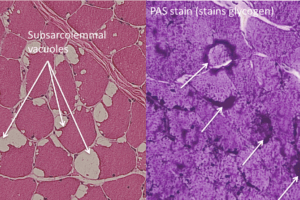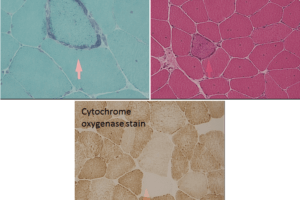Acetylcholine is one of the major neurotransmitters in the mammalian nervous system, found at all neuromuscular junctions, at all synapses in autonomic ganglia, at a variety of locations in the CNS and peripheral end organs.
Acetylcholine Synthesis
Acetylcholine is synthesized from a choline precursor and an acetyl group providing by Acetyl CoA (a cofactor). Choline acetyltransferase (ChAT) is the enzyme that catalyzes the synthesis, and staining for ChAT is regularly used to identify cholinergic neurons. Cholinergic neurons also have an Na+/Choline cotransporter that drives choline into the neuron.
Acetylcholine Clearance
Acetylcholine is quickly cleared from the synaptic terminal by acetylcholinesterase. This enzyme is found in high concentrations at the NMJ and other cholinergic synapses. Ach is degraded into an acetyl group and choline. The choline can then reenter the neuron through the Na/Choline cotransport.
Acetylcholine Receptor Types
Nicotinic Ach Receptors
Nicotinic Ach R are broadly classified into 3 types: NMJ, CNS, and preganglionic. All are ionotropic receptors. Despite these three “classes” there are actually many varieties of nAchRs because each receptor is made up of about 15 subunits, with variants for most of the subunits.
Muscarinic Ach Receptors
Muscarinic Ach R are found in neurons, cardiac muscles, and glandular end organs. Again, despite these three general locations for mAchRs, there are least 5 classes (m1-m5), found at different locations.
Cholinergic synapses in the peripheral nervous system
All preganglionic neurons in the autonomic nervous system (both sympathetic and parasympathetic) release Ach.
All postganglionic neurons in the ANS have nicotinic Ach receptors, so the main communication between preganglionic and postganglionic neurons in the ANS is via nicotinic Ach receptors. As a result, anything that activates (eg. Nicotine) or blocks (eg. Hexamethonium) nicotinic receptors can affect on both the para- and sympathetic systems, and the results are therefore “mixed” looking.
Postganglionic neurons in the parasympathetic system release Ach. End organs have muscarinic receptors. The action of agonists and antagonists depends on the site.
Ach is the neurotransmitter found at the neuromuscular junction, so normal Ach neurotransmission is a requirement for movement.
Cholinergic synapses in the central nervous system
The major cholinergic nucleus in the human brain is found in the basal forebrain (the Basal Nucleus of Meynert). This nucleus projects widely to the cerebral cortex, and cholinergic tone is thought to affect the degree to which neurons in the cerebral cortex are synchronized.



